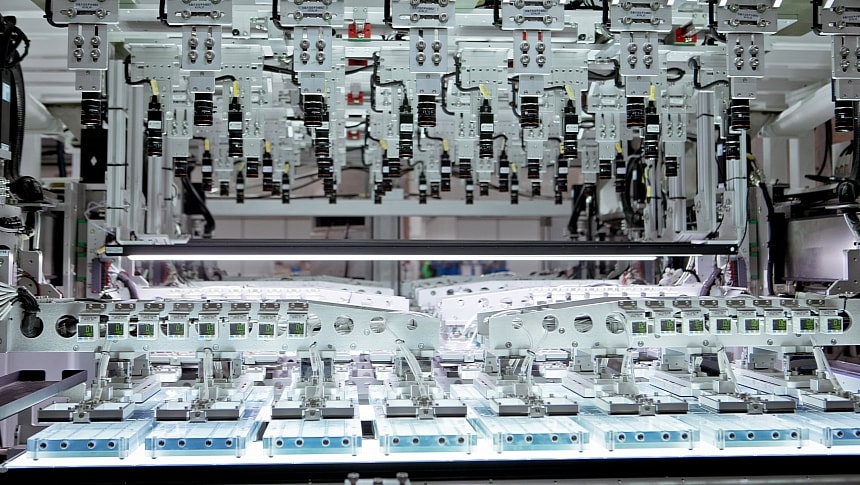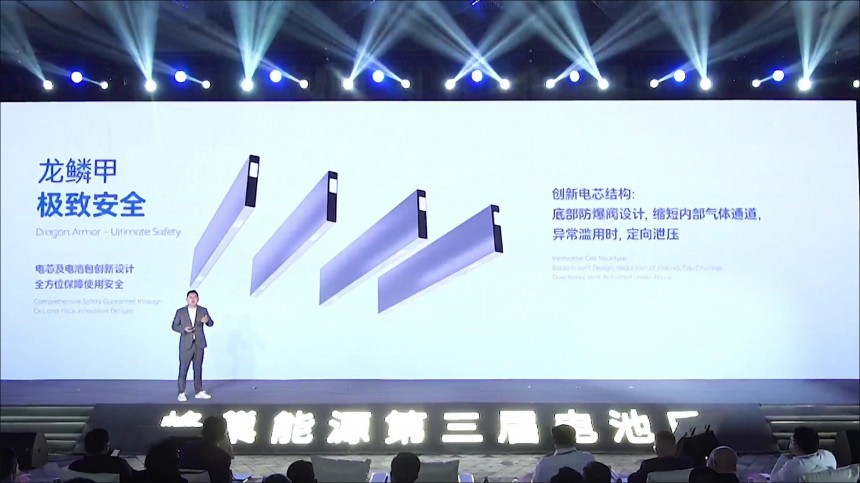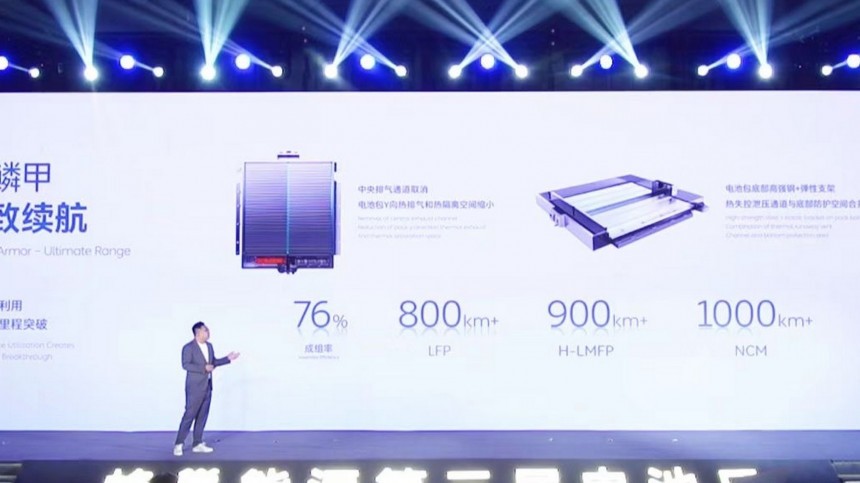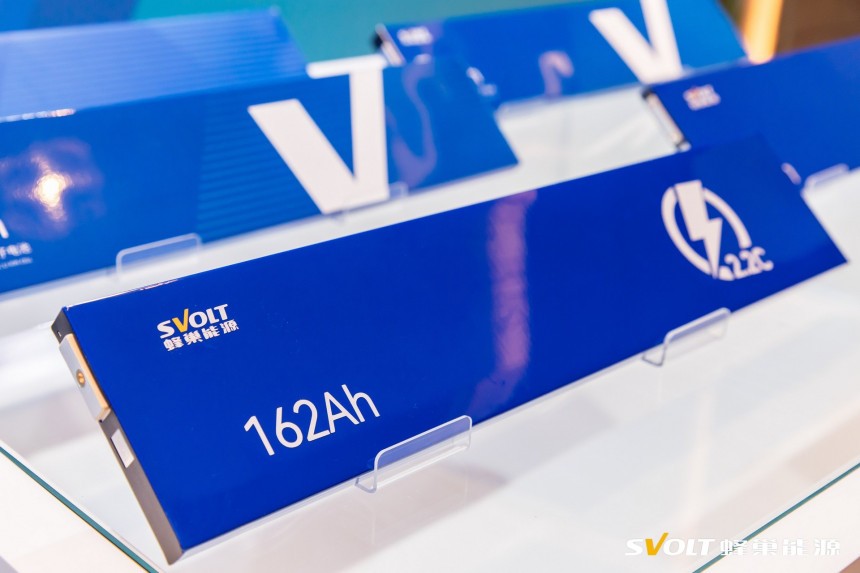In December 2022, I wrote about SVOLT's Dragon Armor batteries for the first time. These cells promised double-sided cooling and cell blast valves, which would minimize thermal runaway effects by releasing pressure as fast as possible. That should prevent nearby cells from being affected. Back to 2024, SVOLT presented an evolution of these batteries, which now focus on fast charging. They come in three flavors, but all of them are Short Blades.
SVOLT said this prismatic format is much better than cylindrical cells, something that several people in the industry agree with because prismatic cells allow for more energy density. The main advantage cylindrical cells have is manufacturing since they are much faster (and theoretically cheaper) to produce. The Chinese battery maker disagrees.
According to SVOLT, cylindrical cells "pose significant production challenges, including high costs and complex manufacturing processes." It tackled them with "a simplified production method that is both cost-efficient and high-performing." The company did not bother to disclose how that manufacturing path works. It just said it is better because it "increases charging speed while reducing production costs" by combining "the benefits of cylindrical cells in a prismatic design."
The most attractive one, apparently, is the 6C, a ternary cell that adopts the already traditional NMC chemistry (nickel, manganese, and cobalt). SVOLT said it can go from 10% to 80% state of charge (SOC) in only five minutes. A true 6C battery would require ten minutes to recharge fully from zero, so we may suppose the other five minutes are the time it takes to reach 10% SOC added to that required to go from 80% to 100%. If that is correct, that shows why fast charging is recommended only between 10% and 80% SOC: it is way quicker than letting it discharge fully to replenish it until the end.
The Chinese battery manufacturer just forgot to mention which charger these batteries need to achieve such a charging speed, but it must be a powerful one, certainly above 250 kW. The company mentions that most battery electric vehicles (BEVs) would get "500 to 600 kilometers during a coffee break," which lacks substance, to say the least. A trustworthy number would depend on how large their battery packs are and how efficient the electric cars are.
Supposing the Lucid Air Pure adopted a 100-kWh battery pack with these Short Blade 6C cells, it would travel 350 miles, or 563 km, considering the EPA cycle. SVOLT will also sell a 120-kWh battery pack with these cells. A Lucid Air Pure with that option would travel 420 miles, or 676 km, if the added weight did not reduce its energy efficiency of 5 miles per kWh, but it would surely do that. A heavier vehicle will never be as efficient as a lighter one of the same kind.
Those who do not like the combination of nickel and cobalt – like Our Next Energy (ONE) doesn't – may prefer the Short Blade 5C cells, which use lithium iron phosphate (LFP). With an energy density of 188 Wh/kg, it takes ten minutes to go from 10% to 80% SOC. Considering a true 5C battery would require 12 minutes to recharge from 0% to 100%, this also shows how LFP cells deal better with fast charges. It would only take two minutes more to recover the 30% SOC left. It is not a coincidence that this will be the first cell to be produced. SVOLT expects to do so by December 2024.
The last new Short Blade cells are called "800 Volt 4C PHEV Dragon Armor." As their name suggests, they are focused on plug-in hybrids, which is probably why SVOLT decided to make them from NMC. This increased its energy density to 250 Wh/kg, which is not a big deal, but it could be if SVOLT uses a cell-to-pack (CTP) construction. In the end, it is the energy density of the battery pack that counts. The Chinese battery maker said these cells can offer 20% more capacity in the same space, but it promises even more. According to SVOLT, these batteries, which will be produced by mid-2025, will also offer electric-only ranges of up to 400 km (249 miles). Currently, that's something only BEVs can achieve.
Couldn't it do the same with LFP cells? It could, but the car would be heavier for the same range. Considering that LFP cells are 5C and these PHEV Dragon Armor batteries are 4C (fully charging from zero in 15 minutes), the range could be shorter due to the faster charging rate. LFP cells are also cheaper and less prone to thermal runaways (catching fire, in a more direct language). BYD makes PHEVs with LFP cells, and they are doing pretty well so far.
As interesting as these new cells are, they only show how the battery makers have to make do with what they currently have. Sadly, it is not much, especially when charging infrastructure still has a long way to go before you can call it minimally reasonable. While lithium metal cells or solid-state batteries do not reach the production stage, we will be stuck with current technologies, which may not have that much room for improvement. In that sense, what the new SVOLT cells promise is quite an achievement. The Great Wall Motors subsidiary only has to prove these batteries can deliver what it promises.
According to SVOLT, cylindrical cells "pose significant production challenges, including high costs and complex manufacturing processes." It tackled them with "a simplified production method that is both cost-efficient and high-performing." The company did not bother to disclose how that manufacturing path works. It just said it is better because it "increases charging speed while reducing production costs" by combining "the benefits of cylindrical cells in a prismatic design."
The Chinese battery manufacturer just forgot to mention which charger these batteries need to achieve such a charging speed, but it must be a powerful one, certainly above 250 kW. The company mentions that most battery electric vehicles (BEVs) would get "500 to 600 kilometers during a coffee break," which lacks substance, to say the least. A trustworthy number would depend on how large their battery packs are and how efficient the electric cars are.
Supposing the Lucid Air Pure adopted a 100-kWh battery pack with these Short Blade 6C cells, it would travel 350 miles, or 563 km, considering the EPA cycle. SVOLT will also sell a 120-kWh battery pack with these cells. A Lucid Air Pure with that option would travel 420 miles, or 676 km, if the added weight did not reduce its energy efficiency of 5 miles per kWh, but it would surely do that. A heavier vehicle will never be as efficient as a lighter one of the same kind.
The last new Short Blade cells are called "800 Volt 4C PHEV Dragon Armor." As their name suggests, they are focused on plug-in hybrids, which is probably why SVOLT decided to make them from NMC. This increased its energy density to 250 Wh/kg, which is not a big deal, but it could be if SVOLT uses a cell-to-pack (CTP) construction. In the end, it is the energy density of the battery pack that counts. The Chinese battery maker said these cells can offer 20% more capacity in the same space, but it promises even more. According to SVOLT, these batteries, which will be produced by mid-2025, will also offer electric-only ranges of up to 400 km (249 miles). Currently, that's something only BEVs can achieve.
Couldn't it do the same with LFP cells? It could, but the car would be heavier for the same range. Considering that LFP cells are 5C and these PHEV Dragon Armor batteries are 4C (fully charging from zero in 15 minutes), the range could be shorter due to the faster charging rate. LFP cells are also cheaper and less prone to thermal runaways (catching fire, in a more direct language). BYD makes PHEVs with LFP cells, and they are doing pretty well so far.
















